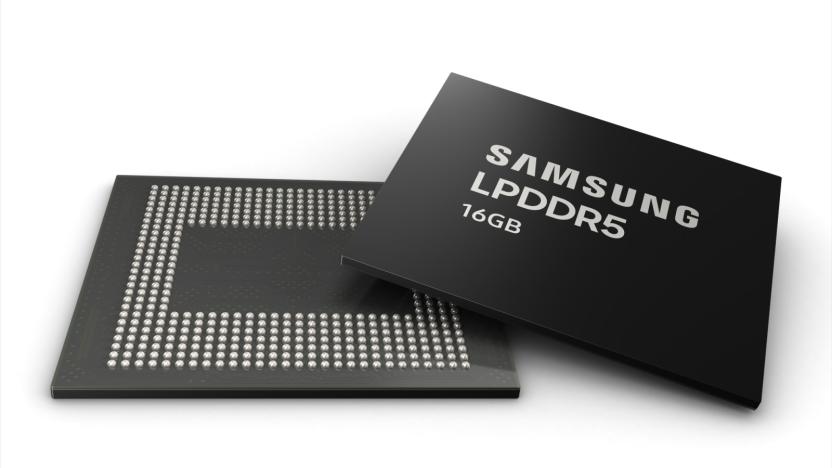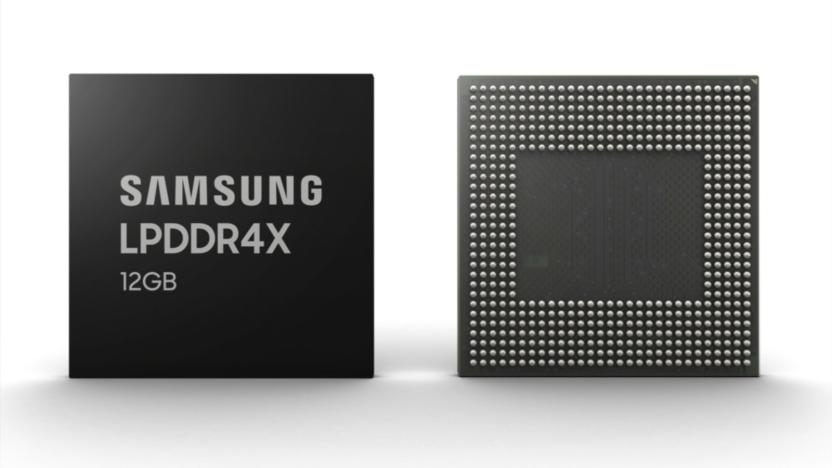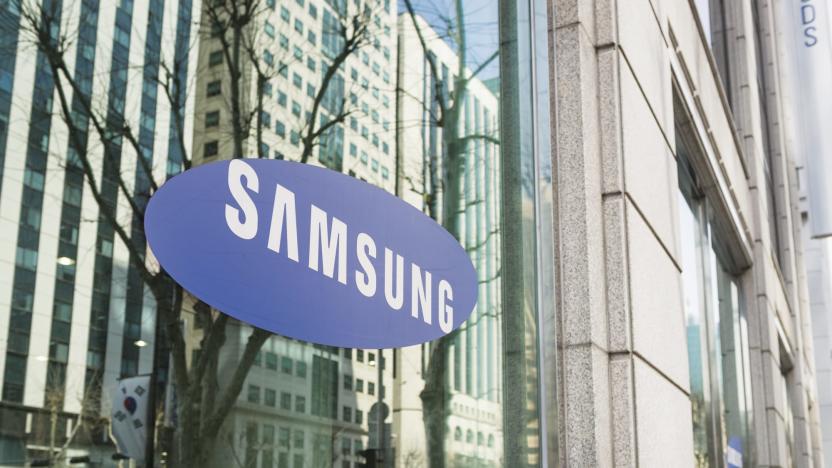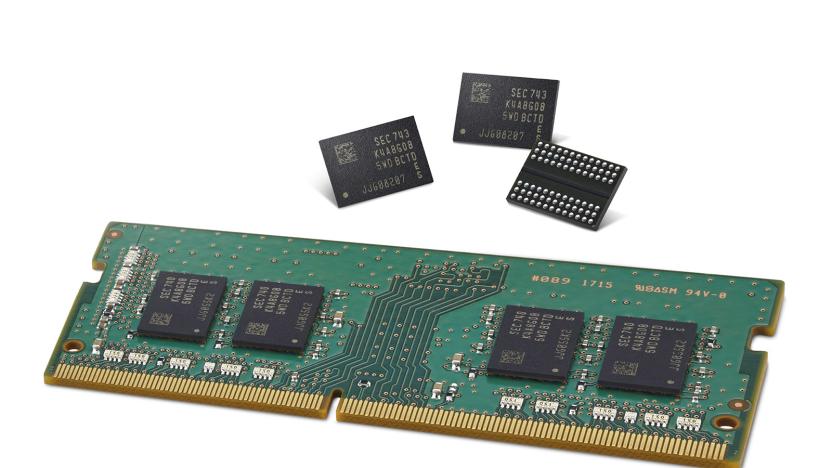DRAM
Latest

Samsung's new chips usher in smartphones with 16GB of DRAM
You could soon see more and faster DRAM in next-generation flagship smartphones than in many PCs. Samsung has just unveiled the first 16GB LPDDR5 mobile DRAM chips built on its second-generation 10-nanometer process tech, the company has announced. We've already seen this chip in Samsung's Galaxy S20 Ultra, and it'll likely appear in more flagship phones in the very near future.

Samsung launches high-capacity smartphone RAM built for 5G and AI
It has only been a few months since Samsung unveiled the highest-capacity smartphone DRAM yet -- a 12GB LPDDR4X package for premium devices -- but it's already following that up with a faster model of the same size. The Korean tech giant has started mass producing what it says is the industry's first 12Gb LPDDR5 for phones, and it'll also start the mass production of 12GB LPDDR5 packages later this month. Samsung introduced its LPDDR5 chip technology last year in hopes of providing 5G phones with a fast, energy-efficient RAM that can power machine learning and AI applications.

Samsung unveils the highest-capacity smartphone DRAM yet
Samsung has unveiled the highest-capacity smartphone DRAM chip yet, a 12GB LPDDR4X package that will give premium smartphones more memory than the average laptop. The chip will be ideal for complex multi-camera devices and folding smartphones with high-resolution screens. "With more smartphones adopting more features, Samsung has seen increasing demand for higher-capacity DRAM chips from phone makers," the company said.

Samsung begins producing its battery-saving memory chips for phones
Smartphone makers are finding it difficult to make their phones stand out in an increasingly competitive market. As well as continuously rolling out new software features and improved displays, sometimes an effective solution can be as simple as upgrading internal components to guarantee better performance and longer battery life. That's what Samsung's second-generation 10nm (1y-nm) class 16Gb LPDDR4X Mobile DRAM is all about.

Samsung's faster, smaller DRAM chips are coming to your next PC
Samsung has built the smallest 8-gigabit DDR4 RAM chip ever using its second-generation 10-nanometer manufacturing tech, it said in a news release. The chips are 15 percent more energy efficient and run 10 percent faster than the last generation, launched just 20 months ago. Productivity for the chips is also up 30 percent, meaning that wafer throughput and yields will let it build more of the chips in the same time. That should make RAM for your computer cheaper and easier to find in the near future.

Sony's latest sensor shoots ridiculous slow-mo video
Sony has unveiled a sensor that could bring some impressive camera tricks to your next smartphone. The 3-layer CMOS sensor does super slow motion at up to 1,000 fps in full HD (1,920 x 1,080), around eight times faster than any other chip. That's possible thanks to a 2-layer sensor married with high speed DRAM that can buffer images extremely rapidly. Specifically, it can capture 19.3-megapixel images in just 1/120th of a second, "four times faster than conventional products," Sony says.

Samsung first to market with 10-nanometer DRAM
Intel may have delayed its 10-nanometer CPUs, but all systems are go for Samsung's 10-nanometer-class DRAM chips. The company is now mass producing the first DDR4 chips using the tech in 8Gb sizes, ahead of competitors SK Hynix and Micron.It will produce SIMM modules this year varying from 4GB for laptops up to 128GB for enterprise servers. Samsung also promised to reveal 10-nanometer mobile DRAM "in the near future."

Samsung starts making 3GB low-power memory for smartphones
We hope you weren't just getting used to having 2GB of RAM in a smartphone, because Samsung is already moving on. The company is now mass-producing 3GB LPDDR3 packages whose 0.8mm (0.03in) thickness can accommodate most device sizes. The capacious, 20nm-class memory should also be quick when there's a pair of symmetric channels to keep data flowing. The first smartphones with 3GB of RAM should ship in the second half of the year; Samsung isn't revealing which phones will have the honor, but it's not hard to make some educated guesses.

Samsung starts production of 20nm 4Gb LPDDR3 mobile DRAM
What is it that you want to know about the RAM in your mobile device? Usually, how much of it there is, and if you're a little more demanding of your hardware, maybe what type it is, too. Well, folk in the latter category might be interested to know that Samsung has started production of 20nm 4Gb LPDDR3 mobile DRAM. As is the nature of smaller, more efficient components, the new chips promise to be faster (2,133 Mbps per pin, over LPDDR2's 800 Mbps), and -- so claims Samsung -- a 20 percent drop in power consumption. With just four of these new chips, OEMs can have a 2GB offering that's still just a slick 0.8mm in height.

JEDEC announces final DDR4 RAM specification
A couple of companies have been jumping the gun on DDR4 production, but the JEDEC Solid State Technology Association is finally bringing order to the industry by releasing its official standard for the next-gen DRAM. It calls for "higher performance, with improved reliability and reduced power" -- which we roughly take to mean: less gigs for better rigs. The DDR4 per-pin data rate standard is 1.6 gigatransfers per second (GT/s) at the minimum and 3.2 GT/s at the top-end, although this cap is expected to increase in future updates (given that DDR3 also surpassed its initial target). Speeds will begin at 2133MHz, a significant jump from your average DDR3 stick, and will also operate at lower power thanks to the Pseudo Open Drain Interface. Check out the PR below if you want to delve deeper into the specs, and if even that's not enough to sate you, head to the source link below to tackle the full documentation. Godspeed!

Samsung starts producing faster 2GB LPDDR3 memory for mobile devices, 128GB flash storage too
While the scales may be steadily tipping towards mobile in the world of DRAM production, there's still plenty of room for technological enhancements. To prove the point, Samsung has just started mass production of what it claims to be the first 2GB LPDDR3 DRAM chip for mobile, which can shuffle information in and out 1,600 Mbps (compared to its 1,066 Mbps LPDDR2 predecessor), with up to 12.8 GB/s of bandwidth. In addition, the manufacturer has also started mass production of a place to hold all of that lovely data, in the form of a 128GB mobile flash storage chip. When will you be able to buy a superphone sporting 2GB of RAM and 128GB of storage? We don't know for sure, but even in the face of adversity all of the components seem to be falling into place.

IHS iSuppli: PCs no longer command biggest share of DRAM market
Times change, this is an indisputable truth. But nothing reminds us of this fact as well as a landmark statistic. If there was ever any doubt about the shift towards of mobile computing, then let this be it: personal computers no longer account for the majority of demand for DRAM chips. With 49 percent of all new memory still headed for PCs, it's hardly time to book the hearse for desk- and laptops just yet, but the statistic from IHS iSuppli remind us of the increasing market share that mobiles and tablets are taking. In fact, even though total DRAM shipments for PCs continues to rise, it's estimated that the total share will slip another 6 percent, to 42.8, between Q2 this year and the end of 2013. Of course, this is good news if you have a vested interest in both, not so good if you don't.

Micron teases working DDR4 RAM module, aims for late 2012 production
JEDEC is still finalizing the standards for DDR4, but that doesn't mean component manufacturers are holding back on developing the tech now. Samsung announced the first DDR4 DRAM module last year, and now Micron has announced that it's developed a working part of its own. Using its 30-nanometer technology, the 4GB x8 part is just the first of many products in the company's DDR4 portfolio -- it will expand to include x16 and x32 parts with initial speeds of 2400 MT/s and eventually the JEDEC's targeted of 3200 MT/s. So when will DDR3 seem like a distant relic? Well, Micron is already sending around samples to clients, and it hopes to begin full-scale production by the end of the year. As always, jump past the break for the full press release.

Elpida files for bankruptcy protection as debts of $5.5 billion are revealed
DRAM Maker Elpida has petitioned for a corporate reorganization (the equivalent of Chapter 11 or Administration) as the company has revealed it is close to collapse. President Yukio Sakamoto is expected to resign as the scapegoat for the calamity as it files for protection at the Tokyo District Court. The company, founded in 1999 as NEC Hitachi Memory Inc. has produced DRAM Products since 2000. It founded three wholly-owned subsidiaries: Tera Probe, which conducted wafer probe testing, Akita Elpida Memory Inc. which handled the back-end processes of DRAM production and Rexchip Electronics Corp, which handled the front-end. After a blockbuster period of invention, a fall in prices and the global recession in 2006 forced the company to enter restructuring with a 30 billion Yen ($372.54 million) Government-backed loan. That swathe of cash was used to pump more money into investment and R&D, but the combination of strong Yen and the Thailand flooding has once again forced the company to come clean about its finances. It revealed today that it had debts of 448,033 million Yen, or $5.5 billion and without the protection of the court wouldn't last too much longer. Times of Japan points to the strength of Samsung's memory offerings as being a big contributor to Elpida's collapse, with president Sakamoto saying that DRAM is now as cheap as a "rice ball."

US government rules three Barth patents invalid, sends Rambus scrambling
Suing's easy. It's the "winning" that trips folks up. Such is the case with Rambus, who has been relying oh-so-heavily on the so-called trio of Barth patents to actively pursue just about every technology company on the planet. For those unaware, Rambus has christened itself as a "technology licensing company," but with the last of three patents used to win infringement suits against NVIDIA and HP being declared invalid, it's probably scrambling for new tactics. According to a Reuters report, an appeals board at the US Patent and Trademark Office declared the patent invalid a few days back, with the previous two being knocked back in September. A couple of months back, Rambus' stock lost 60 percent of its value after a court decision led to the loss of a $4 billion antitrust lawsuit against Micron and Hynix, and we're guessing things won't be any happier when the markets open back up on Monday. The company's next move? "We're evaluating our options," said spokeswoman Linda Ashmore.

Elpida starts shipments of next-gen Wide IO Mobile RAM
Tablets might be all sexy curves and Gorilla Glass, but it's what's on the inside that counts, right? Efficient DRAM mightn't set your heart alight, but Elpida Memory did just start shipping its next generation 30nm "Wide IO Mobile RAM." The firm claims it uses 50 percent less power compared with equivalent DDR2 sticks, letting you caress your beloved device for longer. This economy is thanks to it purring along at just 200MHz, which is even more impressive when you consider it brags a 12.8 GB/s data rate per chip. This pumped, yet frugal, performance comes courtesy of using x512-bit data width -- some ten times larger than that of existing DRAMs. The party doesn't stop there, with the Elpida also debuting its LPDDR3 chip, brushing aside LPDDR2 with twice the data rates at 6.4GB/s a slice, and a 25 percent smaller power-drain in tow. Mass production should commence in 2012, check the source link for the full break-down.

Samsung promotes DRAM chief to vice chairman, implements 'top-two' structure
Samsung reshuffled its managerial hierarchy yesterday, promoting Kwon Oh Hyun, head of its DRAM operations, to vice chairman. Kwon, who successfully steered Samsung through an industry-wide price slump last quarter, will continue to head up the company's chip and LCD divisions, while working alongside Jung Yeon Joo -- the former CEO of Samsung C&T Corporation who was also promoted to vice chairman. The restoration of this "top-two" structure was one of several moves the Samsung Group made on Wednesday, including the announcement of six new presidents. Kwon's advancement, however, is certainly the most noteworthy. As the Korea Times reports, the move has already garnered speculation among industry observers, some of whom believe that Kwon's new position signifies Samsung's equal commitment to both component and product divisions. In a statement, Samsung praised the executive for navigating its DRAM business through choppy economic waters, while crediting him for the "strengthening of Samsung's market leadership in memory products." Read more at the source links below.

The big memory cube gamble: IBM and Micron stack their chips
Manufacturers have been murmuring about 3D memory chips for years, but an escalation in recent radio chatter suggests the technology is on the cusp of becoming commercial. Intel unveiled a Hybrid Memory Cube (HMC) at IDF, which promises seven times the energy efficiency of today's DDR3, and now IBM and Micron have shown their hand too. The pair just struck up a partnership to produce cubes using layers of DRAM connected by vertical conduits known as through-silicon vias (TSVs). These pillars allow a 90 percent reduction in a memory chip's physical footprint, a 70 percent cut in its appetite for energy, and -- best of all -- a radical increase in bandwidth: HMC prototypes have already scored 128Gb/s 128GB/s, which makes 6Gb/s SATA III look like a bottleneck. It certainly sounds like a game-changer, unless of course some rival technology like ferroelectric memory gets there first. Update: Doh, sorry for the wrong caps, which were shrunken by a factor of eight. For comparison, current high-level DRAM delivers around 12.8GB/s. [Thanks, Maximilian]

AMD's getting into the DRAM game, isn't afraid to shoot the outside J
Don't you wish every component in your computer were made by the same company? That's AMD's thinking behind a range of desktop DRAM -- leaping into bed with VisionTek and Patriot Memory who will build the branded modules to Sunnyvale's specifications, tweaked for speed with OverDrive tuning tools. You'll be able to pick up DIMMs in 2GB, 4GB and 8GB flavors -- a low-end "entertainment" model running at 1333MHz and 1600MHz, "performance" edition also at 1600MHz and a Radeon-branded unit that will top the family at 1866MHz. The stuff will be available from retailers like Amazon, Fry's and Best Buy Canada, but we don't know when nor how much it'll cost to bring this level of branding harmony to the inside of your case.

Single-chip DIMM stacks integrated circuits like shingles for greater DRAM efficiency
Cellphone screens may be getting bigger, but the push to shrink all other computing components continues unabated. Invensas is well aware of this, and has come up with new, multi-die memory that promises to be both smaller in size and more capacious than existing DRAM. Called xFD, it mounts integrated circuits in a "shingle-like configuration" on top of one another to accomplish the trick. Such stacking increases speed while reducing power consumption due to much shorter connections between RAM dies than what's found in multi-chip DIMM. Of course, the memory won't be popping up in PCs anytime soon, but the company will be showing off its new tech at IDF next week. While you wait, there's more RAM reading in the PR after the break.











